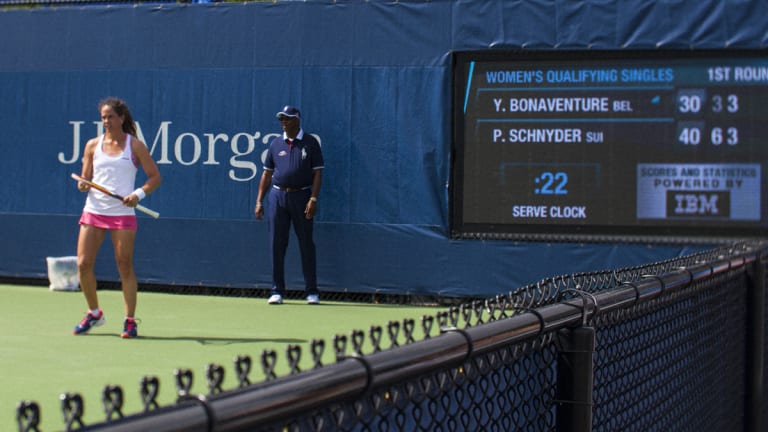NEW YORK—Everything seemed normal during the second day of qualifying at the U.S. Open on Wednesday.
The sun was out and the weather was warm—too warm to plant yourself on a metal bleacher for very long. The courts were filled with little-known hopefuls fighting for their livelihoods. Top players like Karolina Pliskova and Simona Halep, their places in the draw secure, batted flawless ground strokes back and forth in practice. A crowd of fans whooped and leaped and flashed their camera phones when Roger Federer suddenly barreled out of the media center and headed for his hitting session in the Grandstand.
Things were so normal that it was hard to remember that we were in the middle of an historic week: For the first time, tennis was on the clock.
After years of discussion about how to quicken the sometimes-plodding pace of play in the pro game and reduce the time that matches take at all levels, the USTA has installed digital shot clocks—or “serve clocks,” as they’re labelled—on the scoreboards behind the courts at Flushing Meadows during the qualifying rounds. On Wednesday, as the players gathered the balls to serve on one side of the net, and set up to return on the other, the clocks silently began to count down from 25.
That number—25—may be another sign of progress. The time limit between points at the four majors is 20 seconds; at other tour events, it’s 25. There has long been a need to unify them, and 25 is the more reasonable number for today’s physical brand of play. On Wednesday, the 25-second limit allowed the players to go about their usual between-point routines without appearing to be rushed by the ever-decreasing digits at the back of the court.
There are compelling arguments for and against a shot clock in tennis. The best reason to use one is that it lets a player know exactly how much time he or she is using; as of now, they have to guess when they’re getting close to the limit, or wait for a chair umpire to warn them or even penalize them. Yet I was always skeptical of the idea, mainly because I thought it could create more problems that it solved. What happens if a ballperson doesn’t get the ball to the player quickly, and the player is forced to rush, or go over the limit, on a big point? The merciless clock would, presumably, override the umpire’s power of discretion in those situations, and that could be dangerous.


